Let's get started
We'll make sure you're getting the best out of your filtration system
SupaGard
Global Desalination Plant
RO Membrane Protection
Spain
Longer Life, Improved Efficiency, Lower Pressure Drops
Water
Nearly one-fifth of the world's population lives in areas facing water scarcity. This issue is being intensified by climate change and rising demand for water, which together highlight the urgent need for increased potable water capacity through technologies like desalination. Southern Europe has been severely impacted in recent years. Desalination of seawater and brackish water plays a key role in addressing this challenge, and the installed desalination capacity in Europe is expected to grow by 7% annually. In Europe, most of the desalinated water (71%) is used for public water supply, followed by industrial applications (17%), irrigation (8%), and power plants (4%).
Globally, the capacity for desalinated water reached nearly 100 million cubic meters per day in 2022. Of this, 70% was produced in the MENA region (Middle East and North Africa), and 10% in Europe.
Reverse Osmosis (RO) is, and will remain, a vital technology for providing safe, potable water to the world’s populations. In Europe, RO accounts for 88.5% of the installed desalination capacity, while in the MENA (Middle East & North Africa) region, it makes up about 60%, with the rest produced using technologies such as Multi-Flash Distillation (MFD). The difference in the use of these technologies is mainly because MFD is more energy-intensive, and the MENA region benefits from much lower energy costs.
The efficient and cost-effective operation of an RO plant depends largely on protecting the membranes from particulate and organic contamination in the feedwater. This is where the performance of prefiltration systems becomes crucial, as they play a key role in safeguarding the membranes and ensuring optimal plant performance.
Primary filtration of the raw water is typically achieved using a combination of mechanical screens and various mixed beds. Finer filtration may be attained using some self-cleaning wire mesh filters. However, these are limited to nominal 20 micron efficiencies and are not comparable to the efficiencies of dead end filters.
To guarantee the efficient running of the RO membranes, it is generally accepted that the feedwater should be filtered to remove contaminants above 5 microns and have an SDI (Silt Density Index) of < 2.5.
Poor RO membrane protection will lead to multiple problems
All these problems have two major consequences. One is an increase in operating expenses and therefore the cost per cubic metre of desalinated water produced and the other is a significant negative environmental impact.
The best way to ensure the consistent trouble-free performance of the RO membranes is to install a prefilter that can guarantee feedwater quality.
While string wound cartridges provide a low-cost option, they cannot provide consistent performance, especially with increased differential pressure over time. This is due to the compression, flexing, and loss of tension on the textile ‘strings’.
Meltblown depth filters, if manufactured and designed correctly, can provide the desired filtrate quality with excellent in-service life.
Most desalination plants will require roughly 2 m3 of feedwater to produce 1m3 of potable water. These plants vary widely in size but taking the medium example below would require the prefiltration of 10,000 x 2 = 20,000 m 3/day. This would equate to approximately 416 x 40” length filters, sizing at a recommended 0.5m3/hr/10” filter length (2.5” diameter).

When filter changeouts are taken into account this results in a significant amount of consumables needing to be purchased. Historically this has resulted in procurement managers driving down the price of the filters year after year to obtain ‘savings’. The consequence is that lower cost providers take the business with lower specification products. Let’s face it, visually one meltblown depth filter looks very much like another!
The filters may look very similar, but the performance difference can be enormous in terms of on- stream life and the level of protection afforded to the RO membrane.
Let’s look at some recent tests we performed on the comparison of a ‘low-cost’ provider and our SupaGard meltblown depth filter.
We were asked by the operator of a large desalination plant in Spain to evaluate an incumbent’s filter and provide data on the SupaGard as a comparison.
The results were quite illuminating.
There are three main performance characteristics that affect the overall OPEX for the facility.
The chart below shows the lifetime to blockage for our SupaGard filter compared to the competitions standard 5 micron filter, and one they had developed to extend the lifetime. The evaluation was conducted using ISO Fine Test Dust at a concentration of 0.015g/l.
Results show that the SupaGard filters has between 4 and 5 times the life compared to the competitive filter.
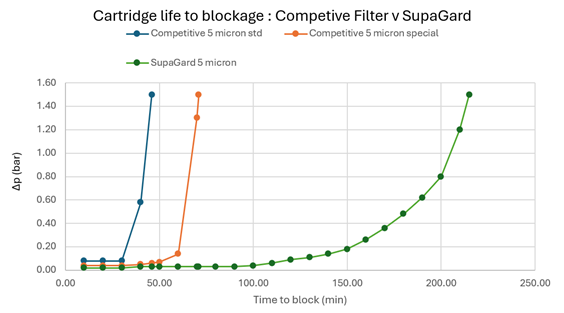
While the competition's ‘special’ design did increase the lifetime of the product, it achieved this by sacrificing efficiency. Efficiency dropped from 80% at 5 micron to 25% as 5 micron. The result of installing this filter into the system could have been catastrophic for the RO membranes.
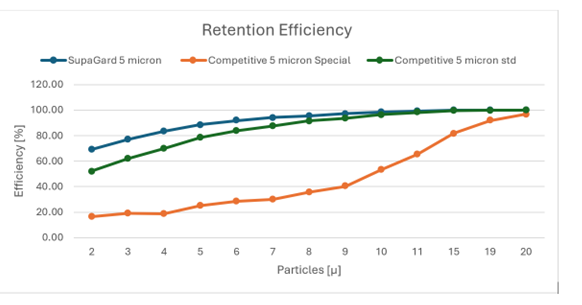
The final test conducted was on flowrate. This showed that the SupaGard exhibited almost half the pressure loss of the competitors standard filter at the same flowrate.
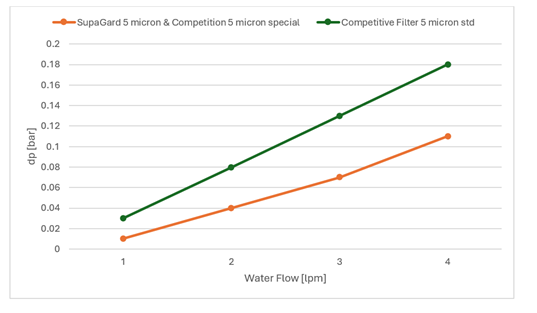
The key takeaway from the testing performed is that the SupaGard filter exhibited higher efficiency, higher throughput (lifetime to blockage) and lower pressure drops than the competitive filter. How is this possible? We saw that when the competitor produced a filter that would supposedly last longer in service it had an extremely detrimental effect on the efficiency.
The answer lies in the filter design and construction. In designing a melt blown depth filter the aim is to maximise the dirt holding capacity throughout the depth of the filter whilst guaranteeing the filters efficiency.
To do this requires a graded density of filtration fibres throughout the depth of the filter. Essentially the filter is more ‘open’ on the upstream side and ‘tighter’ on the downstream side. Through optimisation of the fibre diameters and density, multiple filtration zones can be incorporated into the filter.
Manufacturing filters in this way obviously takes more time and is one of the reasons for price differentials against low-cost providers. However, as has been shown, choosing a technically advanced product will substantially cut operational expenses.
The multiple filtration zones are shown in this cross section of the SupaGard taken after testing – you can clearly see the filters structure capturing bigger particles on the outside and progressively smaller ones through its depth.
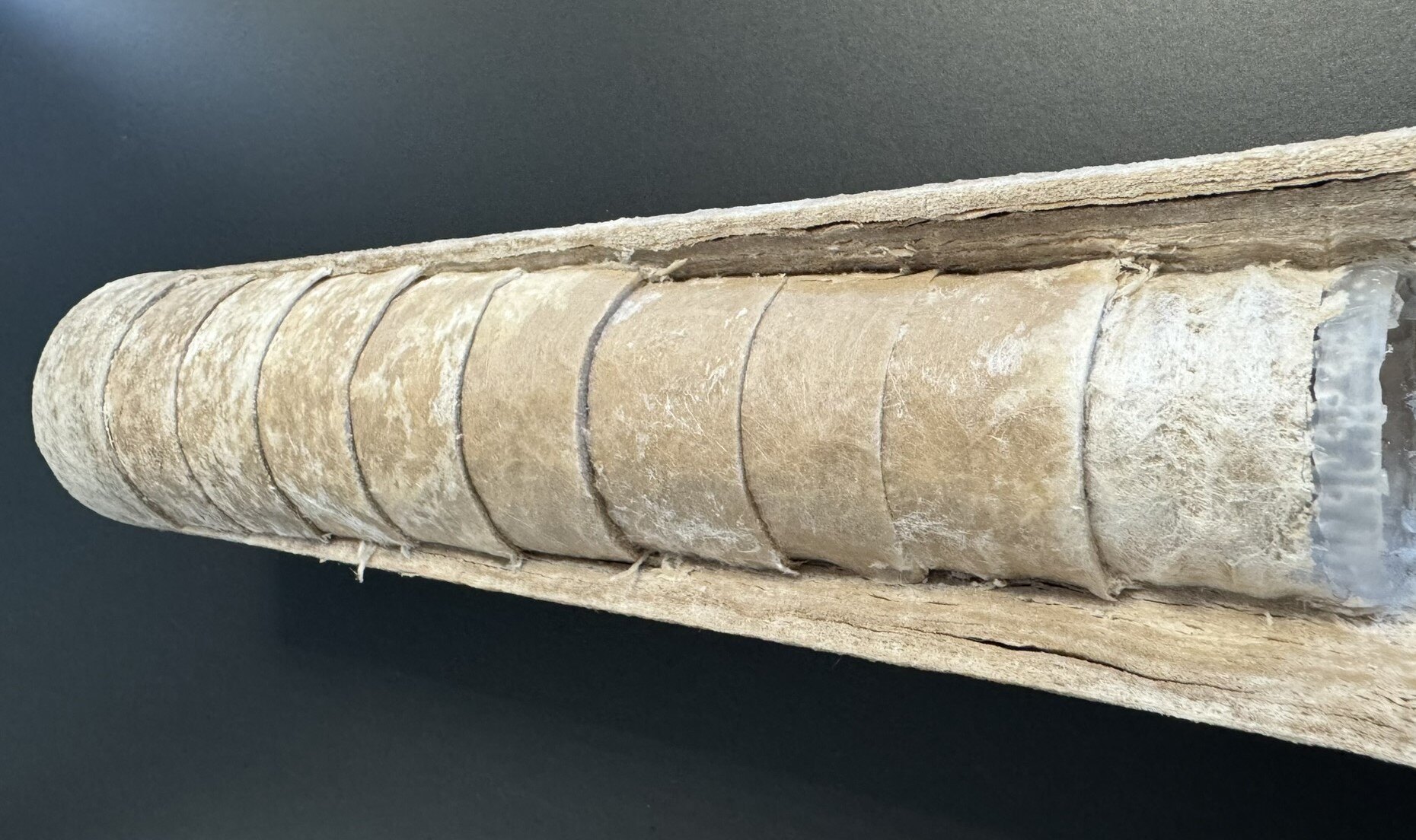
Low-cost meltblown depth filters do not typically have this crucial gradient characteristic due to the way they are made (to minimise cost) and consequently the dirt tends to load on the surface, meaning the full volume of the filter media cannot be used to retain dirt.
The cross section of the competitor filter below shows how the lack of a graded density structure results in preference dirt removal on the upstream surface of the filter resulting in premature blockage and high differential pressure.
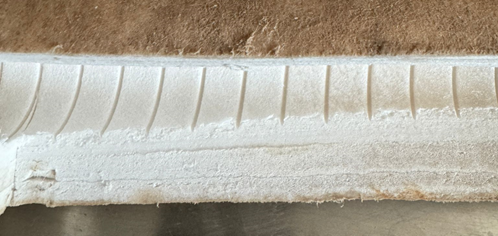
The testing demonstrated that changing to SupaGard would potentially extend the filters life by up to five times while improving the protection and hence extending the life of the sensitive RO membranes.
The added benefit of using less filters is not just financial. It also has a beneficial impact on the environment with less waste post-use.
But there is more! When choosing SupaGard product you can also eliminate the carbon footprint of the filters. How? The sustainable polypropylene we use for our melt blown filtration media is manufactured from bio-methane produced from renewable plant sources. Calculations audited through the ISCC (International Sustainability and Carbon Certification) program show that 2.1kg of CO2 emissions is saved for every 1 kg of standard PP switched to sustainable polypropylene.
As the recognised CO2 emissions for the production of 1kg of standard polypropylene are 1.6-1.7 kg the switch to SupaGard more than offsets that produced by standard filters.
The table below shows the CO2 reduction that can be achieved by switching from a filter manufactured form standard PP to our SupaGard.
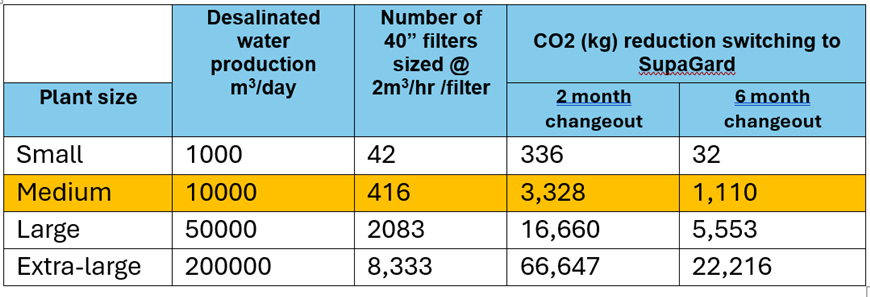
The is another additional benefit the SupaGard range can bring. Depending on the raw water intake quality there can be problems with filter flux rates being reduced due to biofouling of the filter media. Some raw sea water or brackish surface water can contain high levels of organic and biological activity. This may not all be removed by the courser mixed bed prefiltration and can be deposited on the cartridge filters. If there are signs of biofouling the SupaGard filter can be supplied in the KilBac version.
The filtration fibres in this version contain antimicrobial and anti-algal properties that prevent the formation of biofilms. There is some evidence that standard polypropylene can support the growth of alga on the surface.
The use of the KilBac version of the SupaGard filter mitigates this risk and ensures that the filter can do its job or removing particulates without being blinded by biological contamination.
The SEM (Scanning Electron Micrograph) and graphic below show the antimicrobial additive contained in each filtration fibre. The fibres have been developed so the antimicrobial is concentrated on the external surface of the fibre (in contact with the water). This amplifies the effectiveness of the antimicrobial compared to typical antimicrobials.

.jpg?width=500&height=285&name=shutterstock_2374700419%20(1).jpg)
We'll make sure you're getting the best out of your filtration system